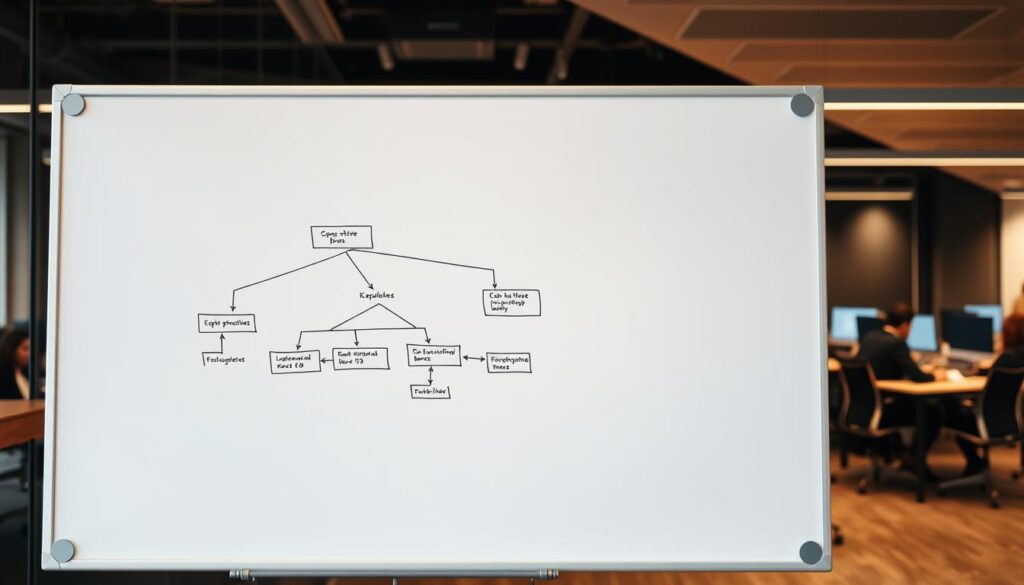An internal wiki helps streamline work within organizations. It creates a central place for sharing info and working together. In today’s quick-moving business world, improving work efficiency is key. An internal wiki improves how we manage knowledge.
This tool organizes important information and cuts down on meetings. Thus, teams can work more on their own and better. Using an internal wiki promotes ongoing knowledge sharing. It also reduces long talks that slow down work.
Introduction to Internal Wikis
Internal wikis act as a vital knowledge-sharing platform. They help people work together by sharing ideas and documents easily. These websites let multiple users edit content at the same time, keeping info up-to-date.
Consider them a living company encyclopedia. They give workers the tools they need to do their jobs well. By using wikis, communication gets better, and old systems become less needed. They give everyone the chance to know important stuff, making the team more efficient.
Understanding Knowledge Management
Knowledge management is about how organizations handle important info. They work to capture, organize, and share this data. This helps them make smart decisions and work efficiently.
Groups focusing on knowledge management see smoother operations. They cut down on unnecessary steps, so finding key resources is faster. A good internal wiki is key, helping staff quickly locate information.
This easy access promotes ongoing learning. It also supports employee growth.
Benefits of Using an Internal Wiki
Internal wikis offer big benefits for modern organizations. The first major benefit of Internal Wiki is promoting improved collaboration among teams. Workers adding to a shared knowledge base make information flow freely and easily.
This easy access speeds up decision-making. It also makes sure everyone has the same information. Such collaboration supports better, quicker decisions and team unity.
Internal wikis also boost productivity by cutting down on time spent searching for information. Workers often waste time hunting for documents or waiting for answers from teammates. A well-organized internal wiki fixes this by having all info in one spot, speeding up replies.
With a central info hub, teams find what they need faster. This reduces frustration and makes getting the right info easier and quicker.
Regular updates to the wiki ensure that the knowledge base stays current and accurate. This helps departments perform better and face challenges more effectively. When everyone helps update the wiki, it builds a culture of working together and ongoing progress. This greatly improves how the workplace functions.
Internal Wiki vs. External Wiki
Knowing the difference between an Internal Wiki and an External Wiki is key for good Knowledge Management. An Internal Wiki is a private space for employees to work together. It keeps secret info safe and helps teams share knowledge easily.
On the other hand, anyone can access an External Wiki. It’s often used to store info about products or to answer common questions. While both wikis are for sharing knowledge, an Internal Wiki’s security helps keep important info safe. This is important for safe teamwork and protecting private details.
Choosing between an Internal Wiki and an External Wiki depends on what a company needs. Each has its benefits, so it’s important for businesses to think about their goals. By using Knowledge Management Tools well, companies can make work smoother and improve communication. This makes sure knowledge is shared the right way with employees and those involved.
Building an Internal Wiki to Reduce Meetings
An internal wiki is a great way for companies to better their work processes and have fewer unnecessary meetings. It puts all the important info in one place making it easy for everyone to find. This helps employees work more on their own and talk better with each other. Getting to info quickly makes talking with each other even better.
How Internal Wikis Enhance Communication
An internal wiki is a place where employees can find everything they need to know. It holds info on key processes, answers to common questions, and updates on projects. It’s a full knowledge center. With access to the same info, teams don’t have to keep asking the same things, making it faster for everyone to decide on their own.
Reducing Dependency on Meetings
Using an internal wiki every day can lower the number of meetings needed. Employees can find answers on their own instead of needing help from others. This means more time for work that matters. This not only saves time but also makes work better, focusing discussions on important things instead of regular team updates.
Essential Features of an Internal Wiki
Focusing on key features is important for a great Internal Wiki. A well-designed wiki improves information access and team collaboration. Look at things like strong search functions, control over access, tracking changes, and tools for teamwork. Each part helps make sure the wiki does a great job for your organization.
Search Functionality and Access Control
Good search tools are a must-have for an Internal Wiki. They let users find what they need fast, saving time. Plus, making sure only certain people can see specific info keeps things private. This way, your team gets the info they need without exposing secrets.
Version Control and Collaboration Tools
Keeping track of document changes is key with version control. It makes sure the info stays correct and trustworthy, which is super important. Also, tools that help teams work together are awesome. They encourage sharing ideas and keep everything current and helpful.
Content Organization in Your Wiki
Getting your internal wiki’s content in order is key for making it work better. A smart setup makes finding information easy and keeps users coming back. To do this right, use a mix of categories and tags. They help guide users straight to what they need. A good Knowledge Structure boosts the perks of Internal Wiki Management. It makes searching for specific info a breeze.
Keeping wiki content current and clear is essential. Regular check-ups and updates ensure your wiki only has the most useful info. This approach cuts down on clutter. It highlights the newest and most important insights. A well-thought-out system for organizing content not only makes the wiki more pleasant to use. It also drives more engagement with the materials available.
Getting Started with Your Internal Wiki
Starting to build an internal wiki is key for better teamwork and sharing info. First, find software that fits your team’s needs well. After choosing the best platform, focus on making a central place for important information.
Creating a Centralized Knowledge Repository
For a successful internal wiki, keep these in mind:
- Gather important stuff like company rules, how things are done, and learning resources.
- Make the repository easy to use, so everyone can find what they need quickly.
- Get people to add their knowledge early on to build a strong teamwork culture.
- Keep the info up to date and correct.
When setting up your wiki, highlight the value of working together. Getting everyone to share what they know makes the knowledge base valuable for all.

Encouraging Team Collaboration
To get the most out of an internal wiki, promoting team collaboration is key. Providing detailed training that highlights how to contribute effectively and the importance of sharing knowledge is crucial. It makes team members feel responsible for adding value.
Keeping the team excited about the wiki requires regular reminders of its benefits. Praising those who contribute boosts a culture where sharing knowledge is valued. It motivates everyone to contribute more.
It’s very important to create a space where feedback is welcomed. Team members should feel free to share their ideas or suggest improvements for the wiki. This kind of open communication helps build a culture of collaboration. It makes the knowledge base stronger and improves how the team works together.
Maintaining and Updating Your Internal Wiki
Keeping your internal wiki useful means regularly updating it. This requires assigning team members to manage the content. Additionally, it’s vital to create a culture where everyone feels involved with the wiki. Set up a review schedule to keep information current and remove what’s no longer relevant.
Regularly Reviewing Content
Reviewing your wiki often makes it a trusted tool for everyone. This helps keep the wiki relevant and encourages people to use it. It boosts teamwork and aids in making better choices at work. Here are important steps to take:
- Assigning team members to oversee specific sections of the wiki.
- Creating reminders for scheduled content review sessions.
- Encouraging feedback from team members on the accuracy and relevance of the content.
- Updating outdated resources and removing irrelevant entries.
Measuring Success of Your Internal Wiki
Measuring the success of an Internal Wiki takes careful planning to see how well it meets its goals. Keeping an eye on Wiki Usage Metrics offers clues about how much people use it and if the content works. These main indicators include:
- Number of active contributors
- Frequency of content updates
- Success rates of search queries
- Employee feedback on how easy it is to find information
Checking these metrics often helps companies find what needs to get better. It’s important to know how the wiki helps in managing knowledge. This way, organizations can make their internal wikis more useful for sharing knowledge and working together.
Conclusion
Adding an internal wiki to an organization changes things big time. It brings lots of pluses that make work smoother and help everyone talk better. This main spot for info makes sharing what you know easy and helps everyone work together better. It cuts down on too many meetings, making work flow better and people more into their jobs.
Looking into the future of managing what we know, internal wikis are super important. They help us use what everyone knows to make smarter choices and keep learning all the time. As companies face new challenges, having an internal wiki is key to staying on top and working smarter.
To wrap things up, getting an internal wiki is more than just a new gadget. It’s about working smarter, not harder. The main points tell us that these tools make employees stronger and help them do great things for their company. With focus and dedication, internal wikis can change the game in how we use and share knowledge at work.



